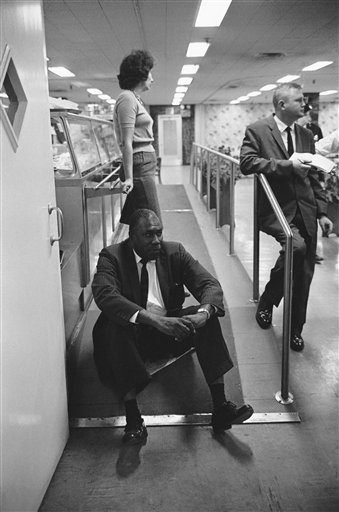The Supreme Court ruled in Brown v. Louisiana, 383 U.S. 131 (1966) that a silent sit-in demonstration protesting segregation in a public library was protected symbolic speech under the First and 14th Amendments.
Men arrested for staging a silent sit-in at a public library
The Louisiana parishes of East Feliciana, West Feliciana, and St. Helena had jointly operated three segregated libraries along with segregated bookmobiles. The three parishes had been the scene of prior civil rights demonstrations, and white public officials in East and West Feliciana parishes were known for their attempts to suppress protests against segregation and attempts to register black voters.
In early March 1964 in Clinton, Louisiana, five black men entered the Audubon Regional Library, a member of the three-parish library system. A library staff member asked if she could help the five men. Henry Brown, reportedly a member of the Congress of Racial Equality (CORE), requested a book. The librarian told him that the library did not have a copy, but that she could order one and notify Brown when it arrived.
The book would be mailed to him, and he could mail it back or return it to the bookmobile for blacks. After completing this transaction, Brown sat in the only chair available to patrons, and the other four men stood around him. They said nothing. Another librarian and the sheriff asked them to leave, but they refused. The sheriff then arrested the three men for violating Louisiana’s breach-of-the-peace statute. They were given a bench trial and convicted. The Louisiana Supreme Court denied their appeal, so the men petitioned the U.S. Supreme Court.
Court upheld the demonstration
The justices ruled 5-4 that the demonstration did not violate Louisiana’s breach-of-the-peace law, but they did not agree on a majority opinion.
In an opinion joined by Chief Justice Earl Warren and Justice William O. Douglas, Justice Abe Fortas held that the right of peaceful protest is not confined to speech, but also includes such expression as silent protest.
Justices Byron R. White and William J. Brennan Jr. concurred in the result, each writing separate opinions. Justice Hugo L. Black, whose strong support for freedom of speech did not include symbolic speech, wrote a dissenting opinion, in which Justices Tom C. Clark, John Marshall Harlan II, and Potter Stewart joined.
Court looked at other sit-in cases in Louisiana
Brown was the fourth Supreme Court case involving convictions by the Louisiana courts for civil rights protests against segregation involving the state’s breach-of-the-peace statutes.
Garner v. Louisiana (1961) involved sit-ins at segregated lunch counters; Taylor v. Louisiana (1962) concerned sit-ins in a segregated bus depot waiting room; and Cox v. Louisiana (1965) involved a large-scale demonstration near a courthouse and jail.
This article was originally published in 2009. Dr. Judith Ann Haydel (1945-2007) was a political science professor at the University of Louisiana-Lafayette and McNeese State University.

